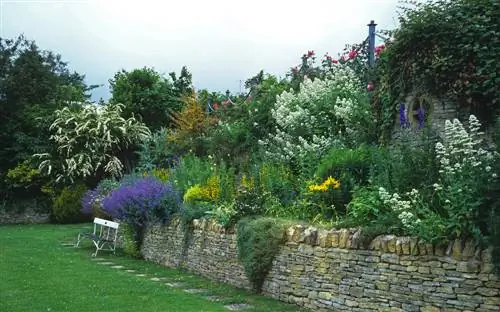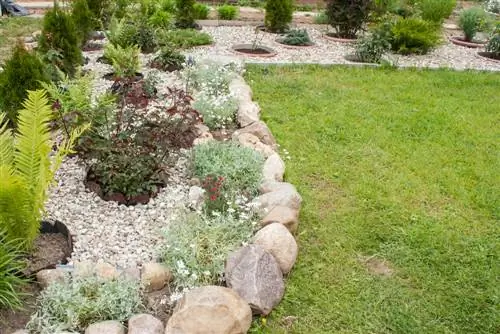- Author admin [email protected].
- Public 2023-12-25 17:45.
- Last modified 2025-01-23 11:21.
Almost all perennials are perennial and hardy. However, you should prepare your perennial bed for winter before the onset of winter so that the perennials can survive any frost. How to do this and a list of the most beautiful hardy perennials can be found below.

How do you design a winter-hardy perennial bed?
Hardy perennials can survive frost, plants with hardiness zone 7 or higher are ideal, e.g. purple bells or thyme. The perennial bed should be covered with bushes and/or leaves in autumn, not cut back and should also be watered in winter.
What does hardy mean?
Winter hardy does not mean that the perennials can survive any sub-zero temperatures. There are also classifications for winter hardiness - into zones:
| Zone | Temperature |
|---|---|
| Z1 | Below -45, 5°C |
| Z2 | -45, 5 to -40, 1°C |
| Z3 | -40, 1 to -34, 5°C |
| Z4 | -34.5 to -28.9°C |
| Z5 | -28.8 to -23.4°C |
| Z6 | -23.4 to -17.8°C |
| Z7 | -17.8 to -12.3°C |
| Z8 | -12.3 to -6.7°C |
| Z9 | -6, 7 to -1, 2°C |
| Z10 | -1, 2 to +4, 4°C |
| Z11 | Above +4, 4°C |
Therefore, the term “hardy” is not particularly clear, as even a plant with a hardiness zone 11 can bear this designation. So pay attention to the additions, which can either be in the form of temperature specifications (“hardy to -20°C), adjectives (very hardy) or zones (hardy Z7). Choose the best for your perennial bed Plants with a winter hardiness of at least Zone7, i.e. around -15°C. Even if the ideal winter hardiness varies slightly depending on the region: Since it rarely gets colder than -18°C in flatter areas such as Berlin or Brandenburg, perennials with a winter hardiness for zone 7 are sufficient. In cooler regions, such as the foothills of the Alps, perennials with a winter hardiness up to zone 6 should be planted.
Preparing the perennial bed for winter
Most perennials are well hardy. But so that they are immune to frost and cold, you should take the following measures in autumn and winter:
- Do not cut back your perennials before winter! Dried leaves and stems protect the roots from the cold. If plants with hollow stems are cut back, moisture will penetrate the perennial and it can rot.
- Cover your perennial bed with bushes and/or foliage, especially in the root zone of your perennials.
- Don't forget to water your perennial bed even in winter (on frost-free days). Perennials are more likely to dry out in winter than to freeze.
Wintergreen perennials
It's clear that the perennial bed doesn't look particularly appealing in winter. However, you can spice up the dreary, sad sight by planting wintergreen perennials whose leaves are frost-hardy on your perennial bed, such as:
- Sandon-forming Waldsteinia
- Colorful purple bells
- Fat Man
- fragrant violets
- Lenzrose
- lily cluster
- Small Periwinkle
- Black Snake Beard
- Star moss
- Thyme
- Wintergreen lavender varieties






